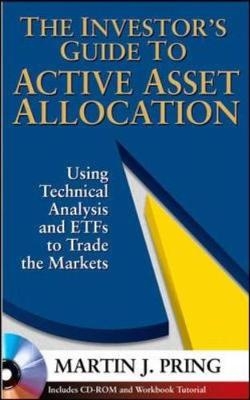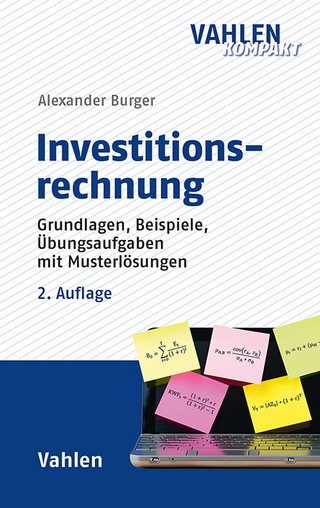
The Investor's Guide to Active Asset Allocation
Seiten
2006
McGraw-Hill Professional (Verlag)
978-0-07-146685-1 (ISBN)
McGraw-Hill Professional (Verlag)
978-0-07-146685-1 (ISBN)
- Titel ist leider vergriffen;
keine Neuauflage - Artikel merken
Offers strategies for taking profitable advantage of changing business cycles. This guide explains the Six Business Cycle Stages and reveals which asset categories perform best during specific stages and provides techniques for making money trading at the various stages.
The Investor's Guide to Active Asset Allocation offers you the background and analytical tools required to take full advantage of the opportunities found in asset allocation, sector rotation, ETFs, and the business cycle.
Written by renowned technical analyst and best-selling author Martin Pring, the book presents Mr. Pring's unique Six Business Cycle Stages, explaining why certain asset categories perform better or worse during different phases of the business cycle, and demonstrating how to use intermarket tools and technical analysis to recognize what business cycle stage the market is in.
Pring shows you how to apply active asset allocation, rotating among sectors and major markets (stocks, bonds, and futures) as the business cycle stage changes, to develop optimum allocation strategies. He focuses on exchange traded funds (ETFs) as the best vehicle for asset allocation rotation, since they are easily traded and have much more flexibility than mutual funds. He also offers specific guidelines for what sectors to be in, depending on the business cycle stage.
The Investor's Guide to Active Asset Allocation provides you with proven investing expertise on:
Basic Principles of Money ManagementHow the Business Cycle Drives the Prices of Bonds, Stocks, and CommoditiesThe Pring Six Business Cycle StagesTechnical Tools that Help to Identify Trend ReversalsPutting Things into a Long-Term PerspectiveRecognizing Stages Using Easy-to-Follow Indicators as well as ModelsHow the Ten Market Sectors Fit into the Rotation ProcessHow Individual Sectors and Groups Performed in Each of the Six StagesAsset Allocation for Specific Stages
This dynamic investing resource features a CD-ROM, which contains supplementary information that will help you execute the strategies described in the book. You'll find live links to useful web sites that contain a wide-ranging library of ETFs, database sources, historical data files in Excel format, and a collection of historical multi-colored PowerPoint charts.
An essential tool for improving your analytical skills, The Investor's Guide to Active Asset Allocation shows you how to move from a passive to an active allocation model and explains the link between business cycle and stock market cycle for more effective - and profitable - trading and investing.
The Investor's Guide to Active Asset Allocation offers you the background and analytical tools required to take full advantage of the opportunities found in asset allocation, sector rotation, ETFs, and the business cycle.
Written by renowned technical analyst and best-selling author Martin Pring, the book presents Mr. Pring's unique Six Business Cycle Stages, explaining why certain asset categories perform better or worse during different phases of the business cycle, and demonstrating how to use intermarket tools and technical analysis to recognize what business cycle stage the market is in.
Pring shows you how to apply active asset allocation, rotating among sectors and major markets (stocks, bonds, and futures) as the business cycle stage changes, to develop optimum allocation strategies. He focuses on exchange traded funds (ETFs) as the best vehicle for asset allocation rotation, since they are easily traded and have much more flexibility than mutual funds. He also offers specific guidelines for what sectors to be in, depending on the business cycle stage.
The Investor's Guide to Active Asset Allocation provides you with proven investing expertise on:
Basic Principles of Money ManagementHow the Business Cycle Drives the Prices of Bonds, Stocks, and CommoditiesThe Pring Six Business Cycle StagesTechnical Tools that Help to Identify Trend ReversalsPutting Things into a Long-Term PerspectiveRecognizing Stages Using Easy-to-Follow Indicators as well as ModelsHow the Ten Market Sectors Fit into the Rotation ProcessHow Individual Sectors and Groups Performed in Each of the Six StagesAsset Allocation for Specific Stages
This dynamic investing resource features a CD-ROM, which contains supplementary information that will help you execute the strategies described in the book. You'll find live links to useful web sites that contain a wide-ranging library of ETFs, database sources, historical data files in Excel format, and a collection of historical multi-colored PowerPoint charts.
An essential tool for improving your analytical skills, The Investor's Guide to Active Asset Allocation shows you how to move from a passive to an active allocation model and explains the link between business cycle and stock market cycle for more effective - and profitable - trading and investing.
McGraw-Hill authors represent the leading experts in their fields and are dedicated to improving the lives, careers, and interests of readers worldwide
| Erscheint lt. Verlag | 16.6.2006 |
|---|---|
| Zusatzinfo | 75 Illustrations, unspecified |
| Sprache | englisch |
| Maße | 158 x 231 mm |
| Gewicht | 721 g |
| Themenwelt | Wirtschaft ► Betriebswirtschaft / Management ► Finanzierung |
| ISBN-10 | 0-07-146685-1 / 0071466851 |
| ISBN-13 | 978-0-07-146685-1 / 9780071466851 |
| Zustand | Neuware |
| Haben Sie eine Frage zum Produkt? |
Mehr entdecken
aus dem Bereich
aus dem Bereich
Allgemeines Steuerrecht, Abgabenordnung, Umsatzsteuer
Buch (2024)
Springer Gabler (Verlag)
28,00 €
Grundlagen, Beispiele, Übungsaufgaben mit Musterlösungen
Buch | Softcover (2024)
Vahlen (Verlag)
24,90 €


